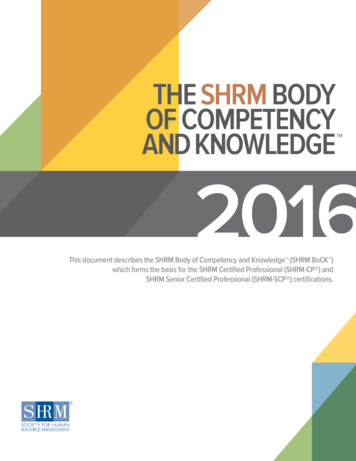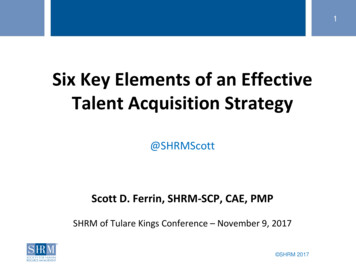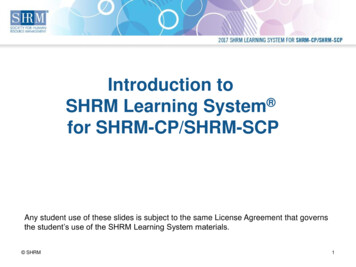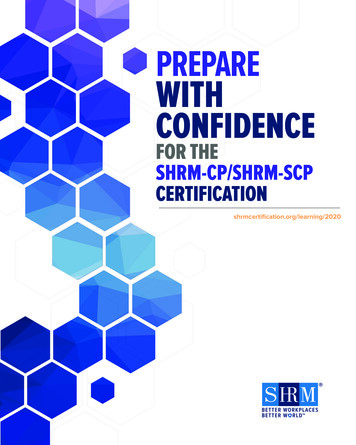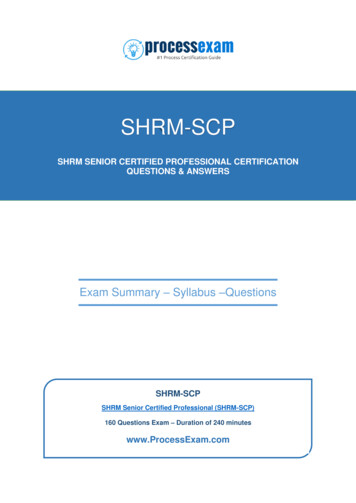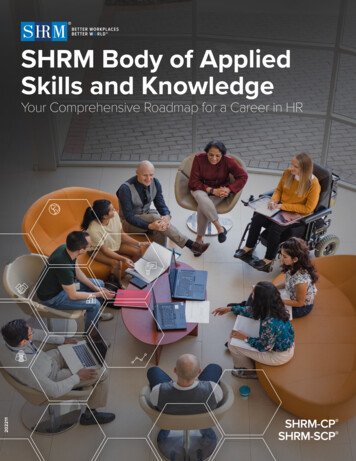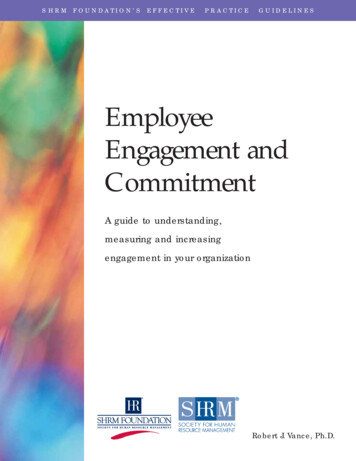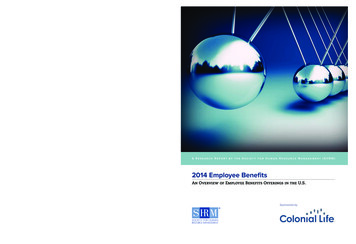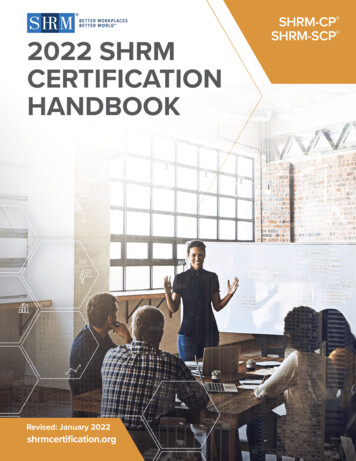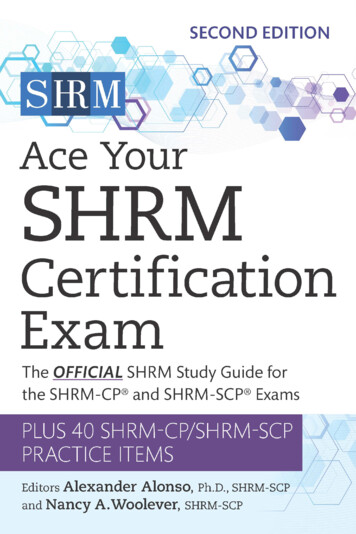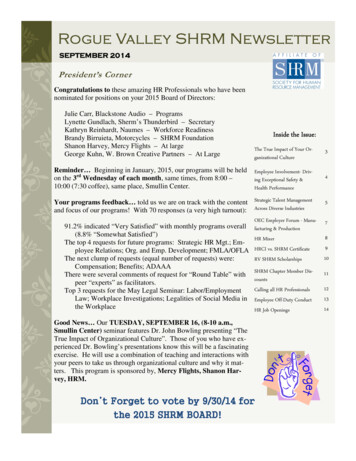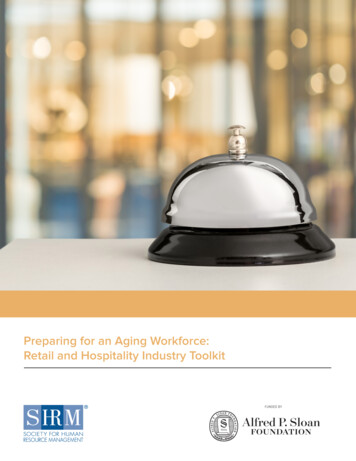
Transcription
Preparing for an Aging Workforce:Retail and Hospitality Industry ToolkitFUNDED BY
Media ContactsKate KennedyPhone: 1.703.535.6260E-mail: kate.kennedy@shrm.orgVanessa GrayPhone: 1.703.535.6072E-mail: vanessa.gray@shrm.orgUSASHRM Headquarters1800 Duke StreetAlexandria, VA 22314Phone: 1.800.283.7476E-mail: SHRM@shrm.orgChinaGateway PlazaChaoyang DistrictBeijing, 100027Phone: 86.10.59231033E-mail: SHRMChina@shrm.orgIndiaGurgaon, Sector 26Haryana 122002Phone: 91.12.44200243E-mail: SHRMIndia@shrm.orgUnited Arab EmiratesDubai Knowledge VillageDubai, UAEPhone: 971.050.104.6330E-mail: SHRM.MEA@shrm.orgOnlineSHRM Online: shrm.orgSHRM Research: shrm.org/researchSHRM Survey Findings: shrm.org/surveysSHRM Research on Twitter: @SHRM ResearchSHRM Research on LinkedIn: LinkedIn.comSHRM Research on SHRM Connect: http://community.shrm.org/homeLegal disclaimer: This material is for informational purposes only and not for the purposeof providing legal advice. You should always contact your attorney to determine if thisinformation, and your interpretation of it, is appropriate to your particular situation.
About the Preparing for an Aging Workforce InitiativeThe Society for Human Resource Management (SHRM) and the SHRM Foundation have launched a national initiative to highlightthe opportunities and challenges of an aging workforce and to identify effective practices for recruiting and employing matureworkers. This three-year initiative is generously underwritten by a grant from the Alfred P. Sloan Foundation.About SHRMThe Society for Human Resource Management (SHRM) is the world’s largest HR professional society, representing 285,000members in more than 165 countries. For nearly seven decades, the Society has been the leading provider of resources servingthe needs of HR professionals and advancing the practice of human resource management. SHRM has more than 575 affiliatedchapters within the United States and subsidiary offices in China, India and United Arab Emirates. Visit us at shrm.org.About the SHRM FoundationThe SHRM Foundation is a 501(c)(3) nonprofit affiliate of the Society for Human Resource Management (SHRM). The Foundationis a legally separate organization and is not funded by SHRM membership dues. The SHRM Foundation is governed by avolunteer board of directors from the HR profession, including academics, practitioners and representatives from SHRM.SHRM Foundation VisionThe SHRM Foundation is the globally recognized catalyst for shaping human resource thought leadership and research.SHRM Foundation MissionThe SHRM Foundation advances global human capital knowledge and practice by providing thought leadership and educationalsupport, and sponsoring, funding and driving the adoption of cutting-edge, actionable, evidence-based research.
Introduction. 1Retail and Hospitality Industry Overview. 2Sector and Occupational Outlook. 2Case Study: Davidson Hotels & Resorts. 4Assessing the State of the Aging Workforce. 5Determining the Impact on Your Organization . 5Building a Business Case for Action. 6Legal Issues to Consider. 9Recruiting and Retaining Mature Workers. 10Steps Organizations Are Taking to Recruit and Retain Mature Workers. 10Creating a Strategy for Actively Recruiting Mature Workers. 12The Role of Benefits in Attracting and Retaining an Aging Workforce. 13Skills, Training and Career Development. 15Endnotes. 19
IntroductionThis toolkit aims to provide HR professionals in the retail and hospitality industries with useful industry-specific informationabout the impact of an aging workforce as well as links to further sources of information, resources, tools and templates. Thetoolkit is based on the materials and information presented in the comprehensive SHRM sourcebook, Preparing for an AgingWorkforce: Strategies, Templates and Tools for HR Professionals. The sourcebook comprises strategies, templates and toolsthat are based on the expert recommendations outlined in the SHRM Foundation’s Effective Practice Guidelines (EPG) reporttitled The Aging Workforce: A Guide to Leveraging the Talents of Mature Employees. The EPG outlines effective practicesused to recruit, retain and manage the talents, knowledge, skills and experiences of an aging workforce. Throughoutthis toolkit, readers will be referred to the sourcebook for more in-depth information and additional practical tools andapplications built around SHRM Knowledge Center guidelines. Industry-specific findings of SHRM’s Preparing for an AgingWorkforce research will be also be discussed throughout.Preparing for an Aging Workforce: Retail and Hospitality Industry Toolkit 1
Retail and Hospitality Industry OverviewThe U.S. Bureau of Labor Statistics (BLS) classifies the retail sector as part of the trade, transportation and utilities supersector, and the leisure and hospitality sector as part of the service-providing industries super sector group. Together,the retail and leisure and hospitality sectors (referred together in this report as “retail and hospitality industry”) employapproximately 31.3 million workers in the United States as of May 2016. Several subsectors compose the retail trade sector,and the leisure and hospitality sector comprises two subsectors (arts, entertainment and recreation, and accommodationand food services). The following NAICS code links lead to BLS information pages that give overviews of employment levels,wages, union representation and other subsector information: Retail Trade: NAICS 44-45 Arts, Entertainment and Recreation: NAICS 71 Accommodation and Food Services: NAICS 72BLS data as of May 2016 for the retail trade sector showed it employed about 15.9 million workers overall with averagehourly earnings of 17.82. The arts, entertainment and recreation subsector, which includes spectator sports, museums andamusement occupations, among others, employed about 2.2 million workers overall with average hourly earnings at 20.47.There were about 13.2 million people employed in accommodation and food services with an average hourly earnings rate of 13.96.Table 1 Earnings DataIndustryAverage Hourly EarningsRetail trade 17.82Arts, entertainment and recreation 20.47Accommodation and food services 13.96Source: BLS (May 2016)Industry and Occupational OutlookMany of the most common jobs in the retail and hospitality industry are low-paying positions with an overall youngerdemographic, making it unlikely that they will employ a high concentration of older workers. This could make it less likelythat workers will stay in these roles beyond average retirement age. The largest occupation within the industry is retailsalespersons, followed by cashiers and several other positions, as shown in Figure 1. Many of these jobs have shorteraverage tenures than other occupations in the U.S. labor force.Looking ahead into the next decade, these sectors will experience similar rates of job growth, although retail positions willbe added to the U.S. labor force at a higher rate than in the previous decade, as shown in Table 2. The pace of job creationin leisure and hospitality will slow in the coming decade compared with 2004-2014. Many job categories in these sectorsare heavily populated by younger workers. However, with steady job growth anticipated in the future, employers in theseindustries may have opportunities to fill those vacancies with older workers and retirees, many of whom take part-time jobsfor additional income to supplement their retirement funds.Preparing for an Aging Workforce: Retail and Hospitality Industry Toolkit 2
Figure 1 Largest Occupations in Retail and HospitalityRetail salespersons4,311Cashiers2,850Combined food preparation and servingworkers, including fast food2,7232,331Waiters and waitresses1,337Stock clerks and order fillers1,090Cooks, restaurant1,083First-line supervisors/managers of retail workers504Cooks, fast food336Customer service representativesHotel, motel and resort desk clerks234Note: Number in thousands.Source: BLS (2015)Table 2 BLS Employment Projections for the Retail and Hospitality Industry: 2014-2024Thousands of JobsIndustryCompound AnnualRate of 42014-2024Retail re and 0.6Source: U.S. Bureau of Labor Statistics Employment Projections: 2014-2024Helpful Resources for Industry/Sector Information and Forecasting Office of Occupational Statistics and Employment ProjectionsNational Employment Matrix (projected employment estimates by industry and occupation are available)National Retail FederationRetail Industry Leaders AssociationNational Recreation and Park AssociationNational Restaurant AssociationAmerican Hotel and Lodging AssociationPreparing for an Aging Workforce: Retail and Hospitality Industry Toolkit 3
Case Study: Davidson Hotels & ResortsAnn Brockett, Complex Human Resources Director, Davidson Hotels & ResortsIndustries that are labor-intensive frequently serve asthe face of the aging workforce in the United States.Manufacturers, for instance, have professed continueddifficulty with finding younger, skilled workers to replace themasses of highly talented and experienced individuals whoare now approaching retirement.In contrast, the hospitality industry—with a workforce thatskews younger than most other sectors—has not been facedwith this dilemma on such a widespread scale. However, it isnot immune from this trend. Ann Brockett, an HR professionalin the Washington, D.C. region, says a significant portionof the housekeeping staff at her hotels will be eligible toretire in the near future, and the nature of the work demandsparticipation from younger generations.“Being a person who is in that [55-and-older] demographicmyself, I could not do housekeeping,” said Brockett, a humanresources director for Atlanta-based Davidson Hotels &Resorts who works in Alexandria, Va. “The general publichas no concept about how hard hotel housekeeping is. It’sphysically very challenging.”Davidson Hotels & Resorts provides management servicesfor 39 hotels in the United States and has about 6,000employees around the country, Brockett said. Brockett isdirector of human resources for two of those properties, theHilton Mark Center in Alexandria, Va., and the Hilton GardenInn Arlington/Courthouse Plaza in Arlington, Va.Only about 10% of the Hilton Garden Inn’s 40 employeesfall into the 55-and-older category, she said, but the MarkCenter’s staff of 250 workers tells a different story. Aboutone-fourth of its payroll belongs to the 55-and-olderdemographic, and several members of its housekeepingstaff have had lengthy tenures—about 60% have been withthe hotel for nearly 20 years, she said.And although turnover overall has been “quite low” at bothhotels, Brockett said that it has not been the case with thehousekeeping division at Mark Center.“Most people that have been here for a long time haveprovided a solid foundation, and obviously they don’t leave,”she said. “They stay forever until they retire. But what I’mfacing on a daily basis is, the new people who replace themoften come in, stay for a few days to two weeks, and thendisappear. In housekeeping, I’ve probably replaced thesame 10 positions at least five to 10 times each in the 10years I’ve been here.”Within the last two years, the number of workers eligibleto retire has slowly increased, making Brockett’s job moredifficult. But a solution may lie in a new program that theMark Center has developed with the local division ofGoodwill Industries International, a nonprofit that providesjob training, employment placement and other services.Together, Goodwill and the Mark Center have created atraining certification program for the hospitality industry,and Brockett was charged specifically with developing thecurriculum for housekeeping. As of the spring of 2016, theprogram was nearly ready to launch.“The students will have a lot of classroom hours at theGoodwill facility, and a certain amount here at the hotel,”Brockett said. “We’ll use the ‘out of order’ rooms for trainingexercises. Ideally, people who successfully complete theprogram will have the first crack at our job openings.”Aside from the physical challenges associated with thehousekeeping work, the round-the-clock nature of thehotel business overall poses barriers for retaining olderworkers, according to findings from SHRM’s Aging WorkforceResearch Initiative. Nearly half (48%) of retail and hospitalityrespondents said their organizations were unable to offerwork hour flexibility such as reduced hours, job-sharing,phased retirement and part-year employment. Thosebenefits can prove attractive for older workers as they winddown their careers.Despite the higher rate of retirements on the horizon,Brockett said she has come to appreciate the value of thehotel’s older workers while they are still around.“The work ethic is the key,” she said. “All of us in thatdemographic grew up during a time when, no matter howhard things got, you went to work in order to survive. Andwhen you’re younger and learning about the job, there’sonly so much you can learn from books. Our experiencedstaff members teach the younger ones about the job andserve as mentors. In this industry, if you can succeed here, Ithink you can do anything in the world. You’re faced with thefact that 24 hours a day, 365 days a year, anything that canhappen will happen.”Preparing for an Aging Workforce: Retail and Hospitality Industry Toolkit 4
Assessing the State of the Aging WorkforceAmong the first steps HR professionals in retail and hospitality fields can take to prepare for an aging workforce is to assessthe current demographics of their workforce and determine how it will evolve over the coming years and decades.Determining the Impact on Your OrganizationThe first and most basic step in assessing the state of the aging workforce in a given organization is to determine whatpercentage of the organization’s workforce is nearing retirement age. According to a SHRM survey of HR professionals atleisure and hospitality firms, nearly one-quarter (23%) of their workforce is age 55 or older, slightly lower than most otherindustries (see Figure 2). More than one out of 10 HR professionals (12%) in retail and hospitality firms said they were notaware that the proportion of older workers was increasing and that older workers were projected to make up approximately26% of the labor force by the year 2022, compared with 21% in 2012 and 14% in 2002. Similar to other industries, more thanone-third (37%) of HR professionals in the retail and hospitality industry indicated their organizations had begun to examineinternal policies and practices to address this change; one-fifth (20%) reported that their organizations had examined theirworkforce and determined that no changes in their policies and practices were necessary, as illustrated in Figure 3.Figure 2 Percentage of Older Workers, by IndustryAccommodation and food services, retail trade,wholesale trade, and transportation and warehousingConstruction, and repair and maintenance23%24%Educational services29%Finance, insurance and real estate29%30%Government agencies26%Health care and social assistanceInformation and professional, scientific and technical services24%Manufacturing27%Mining, quarrying, and oil and gas extraction27%Religious, grantmaking, civic, professionaland similar organizations30%29%UtilitiesOther23%Note: Except for the “Other” group, the accommodation and food services, retail trade, wholesale trade, and transportation and warehousingindustry (i.e., retail and hospitality) employs significantly fewer older workers than the other industries.Source: Preparing for an Aging Workforce: Retail and Hospitality Industry Report (SHRM, 2015)Preparing for an Aging Workforce: Retail and Hospitality Industry Toolkit 5
Figure 3 How Retail and Hospitality Organizations Are Preparing for an Aging Workforce Comparedwith Other Industries12%12%Not aware of this potential changeJust becoming aware ofthis potential change22%19%Beginning to examine internal policies andmanagement practices to address this changeHave proposed specific policy andmanagement practice changes37%36%4%5%Have agreed on a plan to change policiesand management practices3%2%Have implemented specific policiesand management practices2%*7%*20%19%Have examined our workforce and determined thatno changes in our policies and practices are necessaryRetail and hospitalityAll other industries*The difference between retail and hospitality and all other industries is statistically significant (p .05).Note: Retail and hospitality n 188; all other industries n 1,402.Source: Preparing for an Aging Workforce: Retail and Hospitality Industry Report (SHRM, 2015)Building a Business Case for ActionVery few HR professionals in the retail and hospitality industry believed the impact of the potential loss of talent due toretirement of workers was considered an immediate crisis for their industry (3% thought it would be considered a crisis in thenext one to two years and 4% in the next three to five years, as displayed in Figure 4). Therefore, it is likely that few have takenmany concrete steps to build a business case for meeting this challenge. Looking further into the future, more HR professionalsforesaw the aging workforce as a concern for their industry (9% considered it a crisis and 29% a problem in the next 11 to 20years). Generally, HR professionals in the retail and hospitality industry are less concerned about the aging workforce comparedwith their peers in other industries, but that should not eliminate the need to create a plan for dealing with this long-term issue.The industry frequently relies on younger demographic groups to staff its positions, but the fact that older workers will constitutea larger percentage of the workforce in the future presents an opportunity to tap into that talent pool.Depending on the organization, different approaches to building a business case may be followed. In some organizations,informal methods are used to make strategic decisions. HR professionals at small organizations, for example, may only needto have an informal conversation with their organizational leadership team or business owner to get the needed buy-in tomove forward with a strategy. In larger organizations, a much more formal route must be taken.As shown in Figure 5, less than one-third (30%) of HR professionals from retail and hospitality firms said their organizationswere analyzing the impact of workers age 55 and older leaving their organization in the next one to two years. More thanone-half (56%) indicated their organizations were identifying their future workforce needs in the next one to two years, nearlyon par with other industries (58%, see Figure 6). Overall, the findings suggest that although some organizations may not befully aware of the various ways this demographic shift will influence their organization, retail and hospitality organizations arecognizant of these changes and are taking steps to prepare for this shift.Preparing for an Aging Workforce: Retail and Hospitality Industry Toolkit 6
Figure 4 Perceived Impact of the Potential Loss of Talent Due to an Aging Workforce on the Retail and HospitalityIndustry Compared with Other Industries1 to 2 years3 to 5 years6 to 10 years11 to 20 yearsRetail and hospitality 3%13%All other industries 3%30%19%53%*45%*33%Retail and hospitality4%All other industries4%25%*Retail and hospitality5%27%16%*43%37%40%31%42%26%All other industries9%29%40%Retail and hospitality9%29%39%All other industriesIt is a crisis15%27%It is a problemIt is a potential problem33%22%23%26%It is not a problem*The difference between retail and hospitality and all other industries is statistically significant (p .05).Note: Retail and hospitality n 155-185; all other industries n 1,123-1,300. Respondents who indicated “Not applicable” were not included in the analysis.Percentages may not total 100% due to rounding.Source: Preparing for an Aging Workforce: Retail and Hospitality Industry Report (SHRM, 2015)A better understanding of their industry’s and organization’s demographics will help HR professionals in their efforts to createa business case for preparing for an aging workforce. A business case is a presentation to management that establishes thata specific problem exists and argues that the proposed solution is the best way to solve the problem in terms of time, costefficiency and probability of success. The form and level of formality of the business case will vary by organization—some arewritten proposals with supporting financial analyses, whereas others may be slide-supported oral presentations. Whetherthey are written or oral, business cases generally have the same components, as described below. Statement of need. This is the condition or change impelling the function’s action. Recommended solution. The objectives for an ideal solution are defined (the desirable outcomes of such an initiative), andthe proposed action is described in sufficient detail to show how it meets these objectives. In some cases, alternatives maybe described as well, and the reasons why they are not being recommended may be discussed. Risks and opportunities. Risks should include outcomes that could decrease the project’s chance for success, outcomesthat could present new opportunities that would require action, and the risks of doing nothing at all. Estimated costs and time frame. The project budget should include all foreseeable elements (labor, equipment, fees,travel and so on), plus a reserve for the unforeseeable expenditures based on the project’s risk. The time frame shouldkeep in mind the project requirements but also the organization’s needs. Longer or more complex projects may bestructured in phases, with gates or review milestones at which management can decide whether to proceed.Creating a solid business case will help HR professionals in retail and hospitality move forward in a systematic way as theymanage the demographic shifts of their workforce and prepare for even greater future changes.A more in-depth overview of how to build a business case for preparing for an aging workforce is outlined in the free onlineSHRM sourcebook Preparing for an Aging Workforce: Strategies, Templates and Tools for HR Professionals. It includes: An overview of how to create a statement of need and the scope of the issues that should be covered in any business case. A summary of the main risks and costs of inaction experts have identified in relation to the aging workforce. An introduction to the basic steps involved in workforce planning and forecasting. Instructions on calculating turnover and projecting future turnover. Discussion of how job analysis and skills audits can highlight any potential future skills shortages and gaps.Preparing for an Aging Workforce: Retail and Hospitality Industry Toolkit 7
Instructions on how to gauge employee satisfaction and engagement and how to use these findings to create strategies forpreparing for demographic shifts. Samples, forms, templates and tools: Calculating Turnover. Sample Turnover Cost Worksheet. Diversity Survey.Figure 5 Retail and Hospitality Organizations That Have Analyzed the Impact ofWorkers Age 55 and Older Leaving Their Organization Compared with Other Industries1 to 2 years3 to 5 years6 to 10 yearsRetail and hospitality30%35%All other industriesRetail and hospitality28%32%All other industriesRetail and hospitalityAll other industries14%16%Note: Retail and hospitality n 166-178; all other industries n 1,277-1,352.Source: Preparing for an Aging Workforce: Retail and Hospitality Industry Report (SHRM, 2015)Figure 6 Retail and Hospitality Organizations That Have Identified Future Workforce Needs Compared with Other Industries1 to 2 years3 to 5 years6 to 10 yearsRetail and hospitality56%58%All other industriesRetail and hospitality44%43%All other industriesRetail and hospitality23%20%All other industriesNote: Retail and hospitality n 172-191; all other industries n 1,255-1,371.Source: Preparing for an Aging Workforce: Retail and Hospitality Industry Report (SHRM, 2015)Preparing for an Aging Workforce: Retail and Hospitality Industry Toolkit 8
Legal Issues to ConsiderAs they prepare for an aging workforce, HR professionals must have a strong understanding of legal issues to avoiddiscrimination claims. Federal law prohibits employers (and employment agencies and labor unions) from discriminatingagainst applicants and employees who are over the age of 40 on the basis of their age. The Age Discrimination inEmployment Act (ADEA) is administered and enforced by the Equal Employment Opportunity Commission (EEOC), whichissues regulations and guidance designed to explain and implement the law’s protections. For an in-depth overview of legalissues related to an aging workforce, see SHRM’s sourcebook Preparing for an Aging Workforce: Strategies, Templates andTools for HR Professionals, which covers the following issues: An overview of laws prohibiting age discrimination. Proving age discrimination. The legal aspects of planning for change. Legal issues to consider when recruiting. How to navigate the legal issues related to physically demanding jobs. Samples, forms, templates and tools: Basic Equal Employment Opportunity Policy. Statement of ADA Commitment to Interactive Process and Reasonable Accommodation Policies.Preparing for an Aging Workforce: Retail and Hospitality Industry Toolkit 9
Recruiting and Retaining Mature WorkersMany organizations may not be aware of the number of potential retirements they could soon be facing, hence the percentageof those that are developing strategies to attract and retain older workers is low. HR professionals in the retail and hospitalityindustry were as likely as their peers in other industries to report that the aging workforce had prompted changes in their recruitingpractices to at least a small extent (60% compared with 57% in other industries). They were also nearly as likely to report that it hadprompted some level of changes to their retention practices and their general management policy/practices, as shown in Figure 7.Steps Organizations in the Retail and Hospitality IndustryAre Taking to Recruit and Retain Mature WorkersSimilar to other industries, few retail and hospitality organizations said their firms had formal strategies for either retaining (5%) orrecruiting (3%) older workers (see Figure 8). Employee referrals were the most common method of recruiting older workers in theretail and hospitality industry (36%) and in other industries (32%). However, HR professionals in the retail and hospitality industrywere less likely than HR professionals in other industries to use the Internet as a method of recruiting older workers (8% comparedwith 14% in other industries), but more likely to use churches (7%, compared with 3%). Nearly three-fifths (59%) of respondents fromretail and hospitality firms said they did not actively recruit older workers (see Figure 9).Because there are few examples that HR professionals in the retail and hospitality industry can look to for ideas about how tomeet the challenge of recruiting and retention as the workforce ages, research on HR staffing practices that do appear to make adifference in both attracting mature job seekers and retaining those in the older worker demographic, often well beyond traditionalretirement age, can be helpful.Figure 7 Extent the Increasing Age of Organization’s Workforce Has Begun to Prompt Changes in . . .Recruiting practicesRetention practicesGeneral managementpolicy/practicesRetail a
Media Contacts Kate Kennedy Phone: 1.703.535.6260 E-mail: kate.kennedy@shrm.org Vanessa Gray Phone: 1.703.535.6072 E-mail: vanessa.gray@shrm.org USA SHRM .
